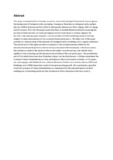Please use this identifier to cite or link to this item:
https://cris.library.msu.ac.zw//handle/11408/4528Full metadata record
| DC Field | Value | Language |
|---|---|---|
| dc.contributor.author | Mhandu, John | en_US |
| dc.contributor.author | Ojong, Vivian Besem | en_US |
| dc.contributor.author | Muzvidziwa, Victor N. | en_US |
| dc.date.accessioned | 2021-11-16T09:36:44Z | |
| dc.date.available | 2021-11-16T09:36:44Z | |
| dc.date.issued | 2019 | - |
| dc.identifier.issn | 1012-1080 | |
| dc.identifier.uri | https://www.researchgate.net/publication/336530639_Modus_operandi_and_the_socio-spatial_milieu_in_which_immigrant_niche_markets_vis-a-vis_informal_economic_activities | - |
| dc.identifier.uri | http://hdl.handle.net/11408/4528 | - |
| dc.description.abstract | This paper is situated within a broader economic, socio-anthropological framework and set against the background of immigrant niche marketing. Drawing on literature on immigrant niche markets (Gemici, 2008:9; Eckstein and Peri, 2018:3) with specific reference to Africa (Ojong, 2005:12; Ojong and Fomunyam, 2011:23), this paper poses that there is invisible literature aimed at assessing the position of niche markets of Zimbabwe migrant women hairdressers in Durban. Against this backdrop, the ongoing paper presents a succinct position of niche marketing research drawing insights on anecdotal evidence of the abovementioned participants. The initial part of this paper provides an understanding of the dynamics of immigrant niche marketing and its operationalization. The second part of this paper provides an analysis on the multiple avenues utilized by the abovementioned participants in order to startup and sustain their businesses in the host country. Key submission made in the section is that social capital, personal savings, and stokvels play a significant role in starting up informal economic activities of the said participants. The penultimate part of this article discourses how Zimbabwe migrant women hairdressers in Durban experience the concept of mixed embeddedness as they participate in informal economic activities. In this paper, we have engaged with fieldwork data, relevant literature, Giddens structuration theory (2003) and Waldinger et al (1990) interactive model of entrepreneurship growth. We conclusively argue that structural synergies of mixed embeddedness as experienced by the said participants are both enabling and constraining and forms that backbone of their enterprise in the host country. | en_US |
| dc.language.iso | en | en_US |
| dc.publisher | School of Social Work | en_US |
| dc.relation.ispartofseries | Journal of Social Development in Africa , Vol.33 , No.2; | |
| dc.subject | informal economic activities | en_US |
| dc.subject | niche marketing | en_US |
| dc.subject | mixed embeddedness | en_US |
| dc.subject | social capital | en_US |
| dc.title | Modus operandi and the socio-spatial milieu in which immigrant niche markets vis-a-vis informal economic activities | en_US |
| dc.type | text | en_US |
| item.openairetype | text | - |
| item.cerifentitytype | Publications | - |
| item.fulltext | With Fulltext | - |
| item.openairecristype | http://purl.org/coar/resource_type/c_18cf | - |
| item.grantfulltext | open | - |
| item.languageiso639-1 | en | - |
| crisitem.author.dept | Midlands State University | - |
| Appears in Collections: | Research Papers | |
Files in This Item:
| File | Description | Size | Format | |
|---|---|---|---|---|
| mhandu.pdf | Abstract | 172.25 kB | Adobe PDF |  View/Open |
Page view(s)
248
checked on Jan 22, 2026
Download(s)
50
checked on Jan 22, 2026
Google ScholarTM
Check
Items in MSUIR are protected by copyright, with all rights reserved, unless otherwise indicated.



